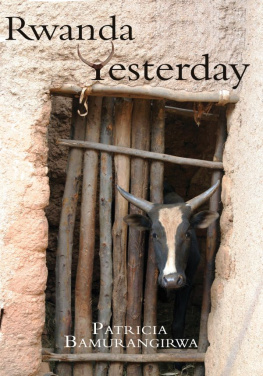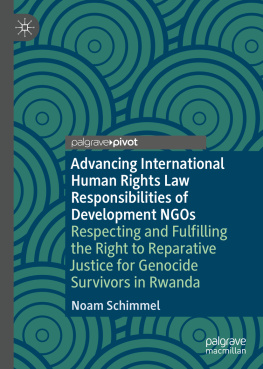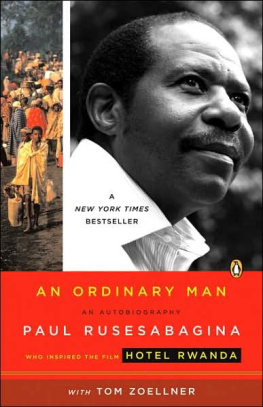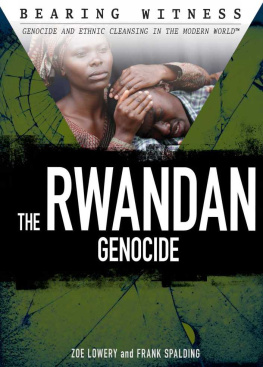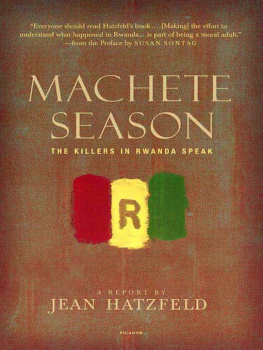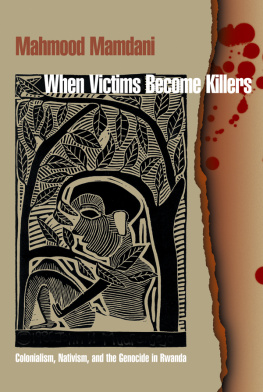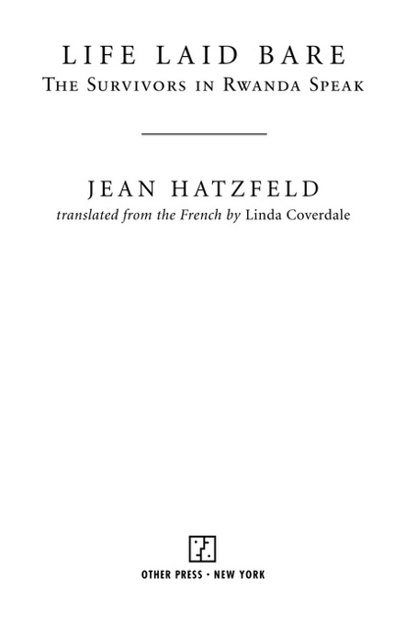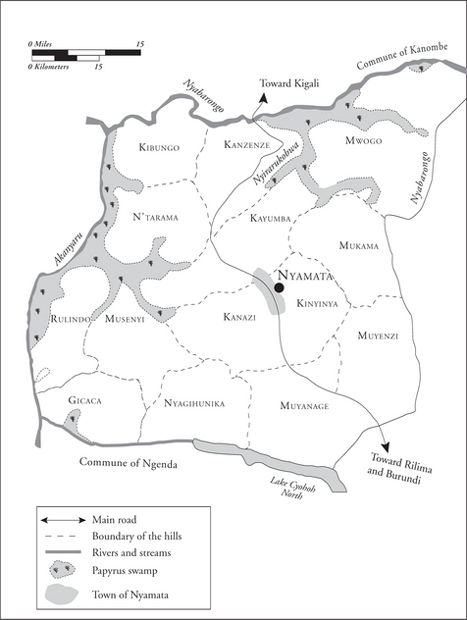ADVANCE PRAISE FOR
LIFE LAID BARE
Jean Hatzfelds Machete Season, wherein the perpetrators of the Rwandan genocide spoke about their crimes, was an astonishing feat of reportage and oral history. Life Laid Bare, which allows the victims to speak, is an even greater achievementa book so elegantly wrought, so unexpected and revelatory, that its absolutely essential reading in understanding what happened in Rwanda, how the survivors of genocide find a way to begin again while never forgetting to bear witness. As Marie-Louise Kagoyire, one of the narrators says, [S]howing our hearts to a stranger, talking about how we feel, laying bare our feelings as survivors, that shocks us beyond measure.
DAVE EGGERS , author of What Is the What
Of all the books I have read about the genocide in Rwandaand I have read many good onesLife Laid Bare is unique. Hatzfeld has a talent for letting the voices of the victims speak directly to us with no apparent mediation. These voices laid bare tell their stories in such a matter-of-fact manner that all explanatory discourses become redundant. One comes out of this harrowing and perversely fascinating book completely devastated, wondering whether this thing we call human in us does really exist.
EMMANUEL DONGALA , author of Johnny Mad Dog
Arresting firsthand accounts of the 1994 Rwandan genocide from 14 men, women, and children who survived the weeks of slaughter. As he did in Machete Season: The Killers in Rwanda Speak (2005), journalist Hatzfeld provides informative introductions to each chapter but allows his subjects to speak for themselves. The collections devastating power comes from the no-holds-barred narratives, with additional kudos to translator Coverdale for rendering their words in spare, haunting English. The details may change, but for the Rwandan survivors, the memories themselves will never disappear. Hatzfeld is to be commended for helping to preserve crucial eyewitness testimony and for sharing it with what one hopes will be a very large audience.
Kirkus Reviews
At the request of the author, the photographs were taken by Raymond Depardon, a member of Magnum and a true friend of Africa, on a visit to Nyamata during the weeks of August 115, 1999, with the exception of one photograph taken by the author on . Copyright Raymond Depardon/Magnum Photos.
Chronology of Events in Rwanda and the District in Nyamata from Machete Season: The Killers in Rwanda Speak. A report by Jean Hatzfeld. Translation copyright 2005 by Farrar, Straus and Giroux, LLC. Reprinted by permission of Farrar, Straus and Giroux, LLC.
eISBN: 978-1-59051-669-0
Copyright 2000 ditions du Seuil
Originally published as Dans Le Nu de La Vie, 2000.
Translation copyright 2006 Linda Coverdale
Production Editor: Robert D. Hack
All rights reserved. No part of this publication may be reproduced or transmitted in any form or by any means, electronic or mechanical, including photocopying, recording, or by any information storage and retrieval system, without written permission from Other Press LLC, except in the case of brief quotations in reviews for inclusion in a magazine, newspaper, or broadcast. For information write to Other Press LLC, 2 Park Avenue, 24th Floor, New York, NY 10016. Or visit our Web site: www.otherpress.com.
The Library of Congress has cataloged the printed edition as follows:
Hatzfeld, Jean.
[Dans le nu de la vie. English]
Life laid bare : the survivors in Rwanda speak / Jean Hatzfeld; translated from the French by Linda Coverdale.
p. cm.
Includes bibliographical references.
1. GenocideRwanda. 2. Tutsi (African people)Crimes againstRwanda. 3. Tutsi (African people)Interviews. 4. RwandaHistory-Civil War, 1994Atrocities.
I. Title.
DT450.435.H3813 2007
967.5710431dc22
2007013924
v3.1
CONTENTS

MAP OF RWANDA
MAP OF THE DISTRICT OF NYAMATA
CHRONOLOGY OF EVENTS
IN RWANDA AND
THE DISTRICT OF NYAMATA
1921 Under a League of Nations mandate, Rwanda and Burundi, formerly part of German East Africa and occupied by Belgian troops during World War I, fall under Belgian rule.
1931 Identity cards specifying the ethnic group of the bearer are introduced, a policy continued until 1994.
1946 Rwanda becomes a UN trust territory and is administered as a Belgian colony and part of Congo.
1959 The last great Tutsi king, Mutara Rudahigwa, dies. The Hutu peasant massacres and revolts that follow cause the exodus of hundreds of thousands of Tutsis.
1960 The Belgian Congo becomes independent, and Rwanda becomes a republic.
1961 The Hutu political parties achieve victory in Rwandas first legislative elections.
1962 The independence of Rwanda is proclaimed.
1963 In Nyamata, the Rwandan army carries out the first widespread massacres of Tutsis.
1973 Major Juvnal Habyarimana carries out a military coup dtat. Large numbers of Hutus fleeing poverty and drought flood into Nyamata, where renewed and repeated massacres occur.
1978 Juvnal Habyarimana is elected president.
1990 The Tutsi-led Rwandan Patriotic Front, which has been assembled from Tutsi militias operating out of Tanzania, Uganda, Burundi, and Zaire, gains its first military victories in Rwanda. Hutu extremist militias, called interahamwe, are organized by the Habyarimana clan.
1993 A peace agreement is signed in Arusha, Tanzania, between Habyarimanas regime and the RPF.
1994 A PRIL 6, 8 P.M . Habyarimana is assassinated when his plane is brought down by a mysterious missile on its approach to Kigali Airport.
A PRIL 7 , EARLY MORNING . Assassinations begin of political figures who did not fully support Habyarimanas dictatorship; the victims include Prime Minister Agathe Uwilingiyimana, a Hutu.
RPF forces immediately begin their drive toward the capital, Kigali, where Hutu interahamwe militias have started slaughtering Tutsis and moderate Hutus. The genocide begins; it will continue for about a hundred days. In Nyamata, small-scale violence breaks out, definitively separating the two ethnic communities on the hills.
A PRIL 9. In Nyamata interahamwe troops launch the first raids to loot and burn houses abandoned by Tutsis and to murder rebellious Hutus; local farmers help them, but without receiving specific orders.
A PRIL 11. After waiting four days for directions from the government, Hutu soldiers from the base at Gako begin systematic killings in the streets of Nyamata. On the hills, the local authorities and


